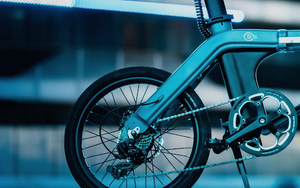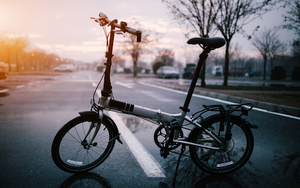Can You Take Electric Scooters on Trains?
May 24, 2024
List of Contents
- Can you take electric scooters on trains?
- Understanding electric scooter regulations
- Electric scooters and public transport
- Preparing your electric scooter for train travel
- Potential challenges and solutions
- Tips for a smooth journey with your electric scooter
- Electric scooter statistics
- Conclusion
Can You Take Electric Scooters on Trains?
Electric scooters have become an increasingly popular mode of transportation in urban areas. With their compact size and eco-friendly features, it's no wonder that many people are opting to use electric scooters for their daily commutes. However, one common question that arises is whether electric scooters are allowed on trains. In this article, we will explore the regulations surrounding electric scooters and train travel, as well as provide tips for a smooth journey with your electric scooter.
Understanding Electric Scooter Regulations
Before we delve into the specifics of taking electric scooters on trains, it's important to have a clear understanding of the regulations that govern their usage. The regulations surrounding electric scooters can vary significantly depending on the country or region you are in. Familiarising yourself with these regulations is crucial to ensure a hassle-free journey.
The Basics of Electric Scooter Laws
Electric scooters are classified as Personal Light Electric Vehicles (PLEVs) in many countries. While regulations may differ, PLEVs are generally subject to similar rules as bicycles. This means that riders are typically required to wear helmets, use lights at night, and follow traffic rules.
How Regulations Vary by Country
It's important to note that regulations regarding electric scooters may vary from one country to another. For example, in some countries, electric scooters are considered motor vehicles and are therefore subject to registration, licensing, and insurance requirements. In contrast, other countries may classify electric scooters as bicycles, allowing riders to use them freely without any additional requirements. It's crucial to research and understand the regulations
specific to the country or region you plan to travel in.

Electric Scooters and Public Transportation
Using public transportation can be a convenient way to travel, especially in busy cities where traffic congestion is a constant challenge. When it comes to using electric scooters in conjunction with public transportation, there are a few things to keep in mind.
General Rules for Transporting Electric Scooters
While regulations vary, most public transportation systems have rules in place for transporting electric scooters. Before embarking on your journey, it's important to familiarize yourself with these rules to avoid any potential issues. Some common rules include folding the scooter to a compact size, placing it in an appropriate storage area, and avoiding obstructing walkways or aisles.
Specific Guidelines for Trains
When it comes to taking electric scooters on trains, there are a few specific guidelines that you should be aware of. Firstly, it's important to check if the train you plan to take allows electric scooters on board. Many train operators have specific policies regarding the transportation of electric scooters. Some may require scooters to be folded and stored in designated areas, while others may have restrictions or limitations based on size or weight.
If you're unsure about the guidelines, it's best to check with the train operator or consult their website for detailed information. Additionally, it's important to be considerate of other passengers and avoid causing any inconvenience or safety hazards.

Preparing Your Electric Scooter for Train Travel
When planning to take your electric scooter on a train, there are a few important factors to consider to ensure a smooth and safe journey.
Safety Measures to Consider
First and foremost, it's crucial to ensure that your electric scooter is in good working condition. Regularly check the brakes, tyres, and battery to optimise safety during your train journey. Additionally, wear appropriate safety gear such as helmets and reflective clothing to enhance your visibility to other passengers and train staff.
Packing and Storing Your Scooter
Before boarding the train, make sure to fold and secure your electric scooter properly. Many electric scooters are designed to be foldable, making them easily storable during train travel. It's important to follow the manufacturer's instructions for folding and securing your scooter to avoid any damage or accidents. The Kugoo G2 Pro can be easily folders up for easy transportation.
While on the train, store your scooter in the designated area or follow the instructions provided by the train staff. Avoid obstructing any walkways or aisles and ensure that your scooter is securely positioned to prevent it from moving or causing any inconvenience to other passengers.

Potential Challenges and Solutions
Travelling with your electric scooter on a train can present some challenges. Being prepared and knowing how to navigate these challenges can help ensure a stress-free journey.
Dealing with Crowded Trains
Crowded trains can pose a challenge when travelling with an electric scooter. If you anticipate that your train is likely to be crowded, consider travelling during off-peak hours to minimise the chances of dealing with overcrowding. Additionally, strategically position yourself and your scooter in a way that minimises obstruction and inconvenience to other passengers.
Navigating Train Stations with a Scooter
Train stations can be busy and complex environments to navigate, especially with an electric scooter. To make your journey smoother, familiarise yourself with the layout of the train station and identify elevators, ramps, or other accessible routes that can be used with your scooter. If needed, seek assistance from station staff who can provide guidance and support.

Tips for a Smooth Journey with Your Electric Scooter
Now that you are familiar with the regulations and guidelines for taking electric scooters on trains, here are some additional tips to ensure a smooth and enjoyable journey.
Choosing the Right Time to Travel
When planning your travel, consider choosing off-peak hours or less busy days, as this can significantly reduce any potential challenges or obstacles that may arise when travelling with your electric scooter. Opting for quieter travel times can also provide you with more space and freedom to manoeuvre your scooter on the train.
Communicating with Train Staff
Communication is key when it comes to a seamless journey with your electric scooter. If you have any questions or concerns, don't hesitate to reach out to the train staff for assistance. They are there to help and can provide guidance on the best practices for transporting your scooter on their trains.

Electric Scooter Statistics
- The electric scooter market is forecast to be worth $50.99 billion US dollars by 2030.
- Electric scooters produce around 35-67 grams of CO2 per km over their lifespan.
Conclusion
In conclusion, whether or not you can take electric scooters on trains depends on the regulations specific to your country or region. By understanding and adhering to the guidelines set forth by train operators and transportation authorities, you can enjoy the convenience of train travel while bringing your electric scooter along for the ride. Remember to plan ahead, follow safety measures, and be considerate of other passengers to ensure a smooth and enjoyable journey with your electric scooter.






